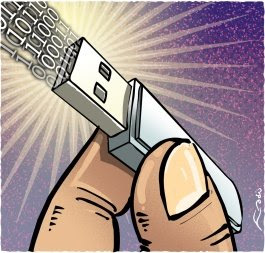
In the news business, the opening sentences of a story are referred to as its "lede" -- spelled that way, journalism lore has it, to avoid confusion with the lead typesetting that once dominated newspaper printing presses. Every sentence in a news story, though, has the potential to spiral off in new directions, and that's where The Lede's mission begins.
Times' Web Guy Mike Nizza Moves to The Atlantic
by John Koblin October 2, 2008
Mike Nizza, blogger behind The New York Times' The Lede, is moving over to The Atlantic to do Web projects. Nizza had been a Web producer at The Times since 2000, and was a key player into the growth of nytimes.com. He left the producing ranks in 2007 to became a blogger for the paper's news digest blog after founding blogger Tom Zeller left for National Geographic.
Here's the memo from digital news editor, Jim Roberts:
In a couple of weeks he'll be taking a job with Atlantic Media, which publishes the Atlantic magazine and the National Journal. Mike will be a senior editor and will create and launch new Web sites and online features for the company.
As many of you know, Mike was instrumental in the development of nytimes.com. He started here in 2000 and quickly rose through the ranks of producer and senior producer before becoming an editor in 2006. I first met Mike when he was running the home page early that year and saw immediately what my predecessors had seen
in him: a well-tuned understanding of the news; an unparalleled depth of knowledge of the Web and the many resources it offered; and a quick agility with technology. Mike was instrumental in the site redesign in 2005 and 2006, and his ability to creatively manipulate the coding on the page gave us great flexibility to produce bold designs for the big breaking news stories of the day.
But Mike knew he could contribute more to the report, and when the job of running The Lede blog opened up in the spring of 2007, he was quick to raise his hand. The rest is history.
On Day One, the awful massacre at Virginia Tech occurred, and Mike turned the blog into a gripping, running account of the developing story … for three straight days. Yes, we had used the blog format to provide live coverage of baseball games and for a few hours of a congressional hearing, but Mike's Virginia Tech report blazed a completely new trail and thoroughly complemented the conventional news stories. With his minute-by-minute updates, he presented material from news conferences, eye-witness accounts, blogs and other materials that he sifted from the Web.
The collapse of a bridge in Minneapolis gave Mike another chance to provide users with a deeper and fast-paced approach to a breaking news story, and when Hurricane Ike plowed through the Texas a couple of weeks ago, Mike was at it again, providing an unending stream of posts that culled reports from our own correspondents, from local news sites and a seemingly unending stream of Twitter updates.
But Mike also found ways to fulfill the original promise of The Lede, exploring stories that spiraled off in new directions. He wrote about modern-day pirates, Tasers and outer space. He could be equally comfortable writing about global famine or Rachael Ray.
Mike also kept us in touch with pop culture. Amy Winehouse made frequent appearances in the blog. And it wasn't a surprise to find Keith Richards or Snoop Dogg. Gawker even took approving note of Mike when he made it clear that he was a HUGE (his word) fan of the Wu-Tang Clan. That prompted one Gawker reader to comment:
Wouldn't it be great if they started to credit him as "Fo Shizza Mike Nizza"?
We will miss him.
Jim Roberts
READ AN ALTERNATIVE IHT DAILY NARRATIVE AT
A PLACE IN THE AUVERGNE
International Herald Tribune
IHT
New York Times
NYT
Vacation /Business Trip Furnished Apartment in Paris

























